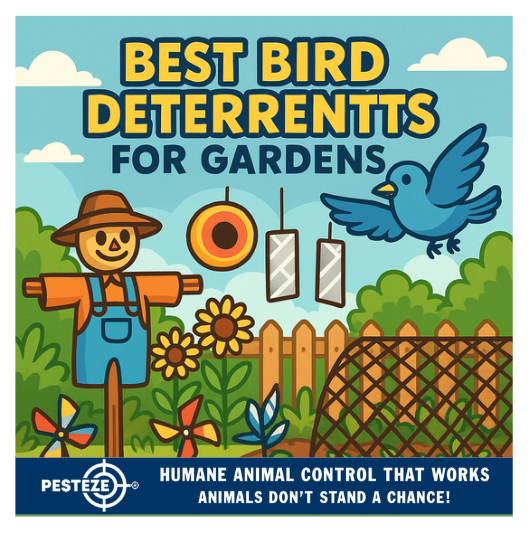BEST BIRD DETERRENTS FOR GARDENS

BEST BIRD DETERRENTS FOR GARDENS
SUMMARY
Birds can damage fruit, veggies, and young plants. The good news is there are humane deterrents that discourage birds without harming them. This guide describes effective options for protecting your garden.
FEATURES
-
Reflective and visual tools: Shiny tape, scare-eye balloons, and mirrors
-
Physical barriers: Netting, wire mesh, and bird spikes
-
Sound deterrents: Predator calls, ultrasonic devices, or noise makers
-
Taste/texture deterrents: Non-toxic sprays or sticky surfaces safe for plants
-
Plants as deterrents: Incorporate species birds avoid
-
Rotational strategy: Change deterrents frequently to prevent habituation
GUIDE DESCRIPTION
Birds are drawn to gardens by seeds, fruits, and insects. Without intervention, they can decimate new growth, peck holes in fruits, or nest in plant covers. That’s why using humane bird deterrents is key to preserving both your plants and the local wildlife.
One of the most approachable methods is using reflective and visual tools. Hanging reflective tape, old CDs, spinning pinwheels, or “scare eye” balloons creates shifting light and movement that unsettles birds. These tools are inexpensive and simple but most effective when moved around periodically so birds don’t get used to them.
Physical barriers are among the strongest defenses. Cover crops or fruit bushes with bird netting, enclose garden beds with wire mesh, or place bird spikes along ledges or fence tops to prevent birds from perching. Make sure barriers are tight and secured so that birds can’t slip through gaps.
Sound deterrents can add another layer of defense. Play recordings of predator calls or wild bird distress calls at intervals. Ultrasonic devices emit high-frequency sounds bad for birds but inaudible to humans. Rotate different sounds and avoid constant repetition so birds don’t become accustomed to the noise.
Another approach is taste or texture deterrents. Commercial sprays (made with natural, non-toxic ingredients) that produce a bitter taste or sticky surface can discourage birds from landing or eating leaves. Use them carefully and only where needed—and wash edible produce before eating.
You can also use plants as natural deterrents. Some flowers and herbs—like lavender, rosemary, or alliums—are less appealing to many bird species. Planting them around vulnerable beds or at the edge of your garden can make the area less enticing without cross-harming the birds.
Finally, rotational strategy is crucial. Birds are intelligent and may habituate to repeated deterrents. Move reflective devices, change sounds, or shift netting positions to maintain unpredictability, which keeps birds wary and less likely to settle in your garden.
By combining visual, physical, auditory, and natural deterrent methods—and rotating them—you can protect your garden from bird damage while maintaining a humane balance with nature.
- Saneeth Thota


Comments 0